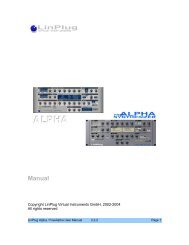CrX4 User Manual - LinPlug Virtual Instruments
CrX4 User Manual - LinPlug Virtual Instruments
CrX4 User Manual - LinPlug Virtual Instruments
You also want an ePaper? Increase the reach of your titles
YUMPU automatically turns print PDFs into web optimized ePapers that Google loves.
Also note that the arpeggio will vary so that when it returns to step one it<br />
will now play an E with velocity of 127 and 1/16 th duration; that's because<br />
the chord has 3 notes while the pattern contains 4 steps. In this case the<br />
arpeggiator will play C-E-G-C followed by E-G-C-E and then G-C-E-G<br />
before starting with the first pattern again. This is very useful for some<br />
rhythmic variations.<br />
The Steps parameter allows you to define how many of the available 32<br />
steps are actually used for a particular arpeggio. Note that wile most<br />
arpeggios may have 8, 16, 24 or 32 steps for rhythmic variation a few more<br />
or less, in example 7, 14 or 15 steps can be amazingly interesting.<br />
The setting of the Gate defines the actual duration of each note. While the<br />
Tempo setting (described next) determines the time subdivision of each<br />
arpeggiator step, the Gate parameter determines how much of this time<br />
subdivision that the note is on and how much it is off.<br />
For example, with the Gate set at 100, the note is the full step length. A<br />
middle setting of 50 means that the note plays for half of the time (for<br />
example if the Tempo parameter was set to 1/16 th then in this case the note<br />
would have an actual duration equivalent to a 1/32 nd note).<br />
Note that the effect of shorter Gate values is only prominent with sounds<br />
that have a short release time.<br />
The Tempo popup menu allows you to set the note subdivision of the<br />
individual arpeggiated notes. For example, when Tempo is set to 1/16,<br />
playing a C-E-G chord in Up mode will play all the chord’s notes at 1/16th<br />
note subdivisions.<br />
The 4 Octave buttons to the left of the Step Display extend the arpeggiated<br />
note range regardless of the octave in which the note was originally played.<br />
For example, setting the Octave to 2 means that the notes of the chord will<br />
be played in the octave in which the chord was originally played, and also<br />
in the octave above. This can be extended up to 4 octaves.<br />
The setting of the retrig (Retrigger) switch determines whether or not a new<br />
chord will restart the Arpeggiator. If Retrigger is activated and there is a gap<br />
between two consecutive chords, the Arpeggiator will restart when the<br />
second chord is played. If Retrigger is deactivated the Arpeggiator will<br />
continue onto the next step when a new chord is played.<br />
<strong>CrX4</strong> <strong>User</strong> <strong>Manual</strong> 52












